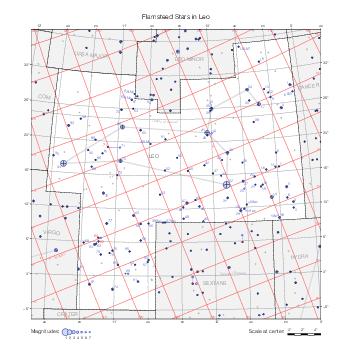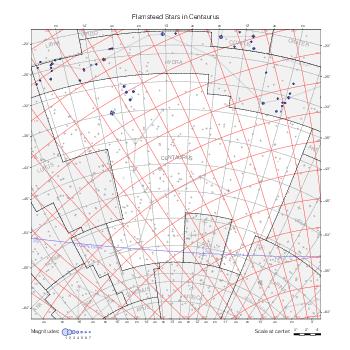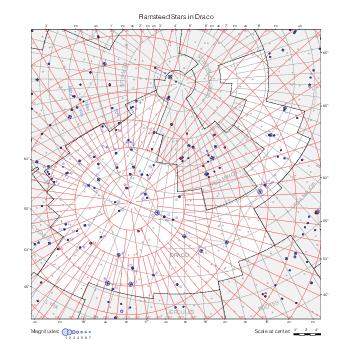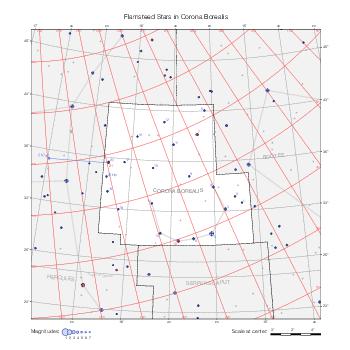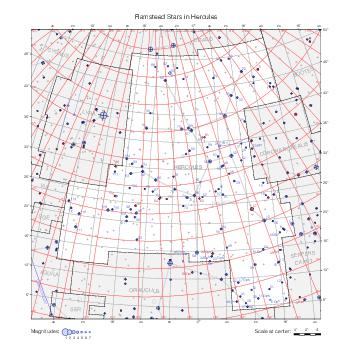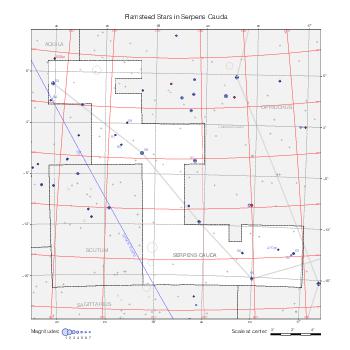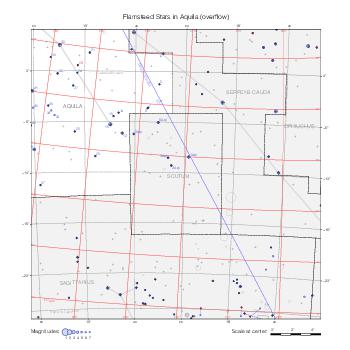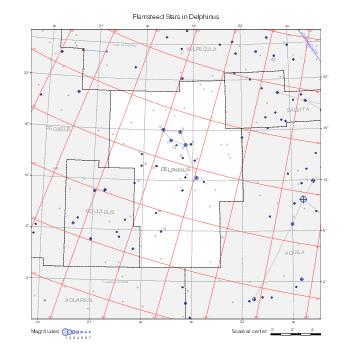Description
The star maps below give a graphical representation of Flamsteed's catalog, one constellation at a time, illustrating some of the features of the catalog described on the previous page. They use the equatorial coordinate system corresponding to the catalog's equinox January 1st 1690 (old style), or
| Julian Day | 2,338,331 |
| Besselian epoch | B1690.0316… |
| Julian epoch | J1690.0369… |
Ordinary stars from Flamsteed's catalog are represented at the positions given by Flamsteed by blue disks. The bright stars from the Yale Bright Star Catalogue and less bright stars associated to Flamsteed stars are represented by + crosses at the positions given by the Hipparcos Catalogue, adjusted to the epoch 1690 according to their proper motion and precessed to the equinox 1690. Each Flamsteed star is linked to its corresponding cross, if any, by a line segment. Flamsteed's positions are so accurate that the line segment is often invisible and the cross falls almost exactly at the center of the circle.
The radius of the disk depends on the magnitude assigned to the star by Flamsteed. For magnitudes given as a range, I have used an interpolated value according to the common convention which translates the range 3-4 to the value 3.33 and 4-3 to 3.66, for instance. For some stars, the magnitude is replaced by the abbreviation tel (telescopic), neb (nebulous), obs (obscure), or completely absent. I have assigned arbitrary magnitude values to these special star types according to the following table and given a dotted border to nebulous objects.
| Magnitude | Assigned value | Cases |
|---|---|---|
| none | 6.0 | (10 cases) |
| obs | 7.0 | 7 Cap, 10 Cap, 12 Cap |
| tel | 8.0 | 7 Ari |
| neb | 4.0 | 33 And, 55 And |
The maps also represent as red disks the positions corrected or supplied by F. Baily in his updated version of the British Catalogue, as explained on the previous page. These corrections bring all the existing stars of the catalog in pretty good agreement with their modern positions.
Modern constellation boundaries precessed to the equinox 1690 are represented for reference. Flamsteed designations are given (in blue, or red if the position has been corrected) for the stars of the constellation under consideration and stars from neighboring constellations that fall within its modern boundary. The label includes the constellation abbreviation when it doesn't match the modern constellation corresponding to the star's position.
With these conventions in place, all the Flamsteed stars appear on the maps except 5 Cyg and 38 Cyg which remain without position even after applying the corrections (they are listed as non-existent anyway). The other non-existent stars appear as lonely disks. The wildly erroneous position of 33 Com from Flamsteed's catalog is not represented. Duplicate entries are recognizable by their double labels on the map corresponding to their actual constellation.
Maps
The maps are arranged in the same order as the constellations in Flamsteed's catalog. Maps covering Microscopium and Scutum have been added because they contain stars respectively assigned by Flamsteed to Piscis Austrinus and Aquila that would not be visible on any other map.
The maps are framed around the modern constellation boundaries exactly like these reference maps in order to facilitate the comparison. The Flamsteed map and the corresponding reference map can be superposed on the monitor, and flipping from one to the other reveals the modern star designations and star names, the precession of the coordinate systems from Flamsteed's epoch to J2000.0, and even the change of position of stars with high proper motion.







